PDF Version
March 2009
Shunji Wang
Small Business Branch, Industry Canada
Summary:
Highlights
- In 2004, innovative SMEs (firms that allocate more than 20 percent of their investment expenditures on research and development (R&D)) represented 4.2 percent of SMEs in Canada.
- In 2004, 34.5 percent of innovative SMEs sought external financing compared with 23.2 percent of non-innovative SMEs in Canada. Of those innovative SMEs, 54.2 percent were approved for financing compared with 83.0 percent of non-innovative SMEs.
- Innovative SMEs were more likely to approach chartered banks for debt financing.
- Innovative SMEs were three times more likely to request equity financing from a venture capital firm.
- Only 4.9 percent of innovative SMEs requested equity financing; however, they represented 44.3 percent of the total financing received. Most of the equity financing received was raised from venture capitalists, friends and relatives.
- Innovative SMEs were about six times more likely to use the debt financing requested for R&D.
- Innovative SMEs paid higher interest rates than non-innovative SMEs.
- Innovative SMEs had fewer employees than non-innovative SMEs.
- In 2004, 10.8 percent of innovative SMEs operated in the wholesale/retail industry, 22.6 percent in professional services and 18.0 percent in knowledge-based industries.
- Ontario had the highest share of innovative SMEs (49.5 percent), followed by Quebec (24.1 percent).
Introduction
Innovation is crucial for maintaining firm competitiveness and increasing standards of living. Financing innovation can be difficult as innovative activities and assets are usually intangible, thereby making the assessment of their monetary values difficult. In addition, innovative firms are usually considered more risky as their chances of success are more difficult to assess. This report describes financing activities of innovative small and medium-sized enterprises (SMEs) in Canada and provides a comparison with non-innovative SMEs. In this analysis, research and development (R&D) intensity is used as a measure of innovation. SMEs that spend more than 20 percent of their total investment expenditures on R&D are defined as innovative firms; those that spend 20 percent or less of their total investment expenditures on R&D are defined as non-innovative SMEs. There exists a substantial body of research that addresses the topic of innovation; however, there is little research on financing innovative SMEs. Thus, studying financing of innovative SMEs will provide valuable information on experiences, instruments used and financing conditions.
This report uses the comprehensive database of the Statistics Canada Survey on Financing of Small and Medium Enterprises. This survey was launched in 2000 by Statistics Canada in partnership with Industry Canada and Finance Canada and is conducted every three years. It measures the demand for and sources of financing of Canadian SMEs, including data on the application process, firm profiles and demographic characteristics of SME ownership. This report is based on the 2004 survey results and tries to address the following research questions:
- Are the financing activities and experiences of innovative SMEs in accessing financing different from those of non-innovative SMEs?
- Do innovative SMEs face different financing terms and conditions than non-innovative SMEs seeking financing?
- What are the substantial obstacles to accessing financing faced by innovative SMEs?
Data
In Canada, SMEs are defined as enterprises with fewer than 500 employees and less than $50 million in annual revenues. The cross-sectional data used in this report are taken from Statistics Canada's Survey on Financing of Small and Medium Enterprises, 2004.
The starting point for defining the target population for the survey of SMEs was to include all enterprises that were on the Statistics Canada Business Register (BR) Universe File dated August 2004. The BR contains the universe of enterprises in Canada. Once the Universe File was created, some enterprises were removed based on auxiliary information that was available from the BR. The following enterprises were excluded from the population:
- Enterprises with 500 or more employees
- Enterprises with more than $50 million in gross revenue
- Enterprises coded as being non-profit (e.g. schools, hospitals, charities)
- Co-operatives
- Joint ventures
- Municipal/federal government
- Other industries for which financing is not of interest (see the Appendix for a list of all industries excluded, based on the North American Industry Classification System)
Other exclusions, such as subsidiaries, could not be identified based on the sampling frame information. Such companies were screened out at the collection phase. The final sampling frame contained 1 939 780 enterprises. After adjusting the initial sample weights to account for refusals, non-responses and those enterprises that could not be contacted, the total target population count was 1 357 348 enterprises.
The Survey on Financing of Small and Medium Enterprises, 2004, was conducted between September 2004 and March 2005. There were 13 042 SMEs that responded. Statistics Canada considered this sample size to be large enough to reflect the whole universe of SMEs in Canada. The survey distinguishes innovative firms (those that spend more than 20 percent of their total investment expenditures on R&D) and compares their activities and experiences in accessing financing with those of non-innovative SMEs. It also questions firms on whether their financing is intended to support growth. Table 1 presents the population of innovative and non-innovative SMEs.
| Weighted | Unweighted | |||
|---|---|---|---|---|
| Frequency | Percent | Frequency | Percent | |
| Source: Statistics Canada, Survey on Financing of Small and Medium Enterprises, 2004 | ||||
| Innovative SMEs | 57 009 | 4.2 | 425 | 5.2 |
| Non-innovative SMEs | 1 300 339 | 95.8 | 7 687 | 94.8 |
The unweighted sample consists of 13 042 observations. Excluding non-responses, there were 8112 respondents remaining: 425 innovative SMEs and 7687 non-innovative SMEs. The weighted sample consists of 1 357 348 observations: 57 009 innovative SMEs and 1 300 339 non-innovative SMEs. The weighted sample is used in this report as it reflects the whole economy.
Table 2 illustrates the differences in characteristics between innovative and non-innovative SMEs.
| Characteristics | Innovative SMEs | Non-innovative SMEs | |
|---|---|---|---|
| Note * of Table 2: Full-time equivalent employees = Number of full-time employees + Number of part-time employees × 0.5) Source: Statistics Canada, Survey on Financing of Small and Medium Enterprises, 2004. | |||
| Age of majority owner | Under 40 years | 51.9% | 53.3% |
| Managerial experience of majority owner | More than 10 years | 54.9% | 69.9% |
| Ownership | Majority-owned by men | 67.8% | 63.3% |
| Equal partnerships | 16.5% | 20.5% | |
| Majority-owned by women | 15.7% | 16.2% | |
| Year firm starting selling goods and services | 1-2 years old (started during 2002-04): | 22.9% | 10.7% |
| 3-6 years old (started during 1999-2001): | 25.1% | 18.8% | |
| 7 years + (started prior to 1999): | 52.0% | 70.5% | |
| Export activity | Exporters | 21.4% | 7.7% |
| Revenues generated from exports | 41.2% | 31.9% | |
| Growth intention | Intended to expand business | 72.7% | 37.6% |
| Industry | Agriculture/primary | 2.9% | 10.1% |
| Manufacturing | 5.0% | 4.8% | |
| Wholesale/retail | 10.8% | 15.2% | |
| Professional Services | 22.6% | 11.0% | |
| Knowledge-based Iindustries | 18.0% | 5.5% | |
| Tourism | 5.2% | 8.3% | |
| Other industries | 35.6% | 45.1% | |
| Region (share of population in parentheses) | Atlantic provinces | 2.6% (7.3%) | 6.1% (7.3%) |
| Quebec | 24.1% (23.6%) | 20.0% (23.6%) | |
| Ontario | 49.5% (38.8%) | 36.3% (38.8%) | |
| Prairies | 11.6% (16.8%) | 21.7% (16.8%) | |
| British Columbia | 12.0% (13.1%) | 15.7% (13.1%) | |
| Territories | 0.2% (0.4%) | 0.2% (0.4%) | |
| Number of full-time-equivalent employees Note * referrer of Table 2 | Zero full-time equivalent employees | 65.1% | 48.2% |
| Fewer than 100 full-time-equivalent employees | 34.8% | 51.5% | |
| 100-499 full-time-equivalent employees | 0.2% | 0.3% | |
Results and analysis
This section presents findings on the financing activities and experiences of innovative and non-innovative SMEs. Part A focuses on accessing financing, Part B looks at financing terms and conditions for SMEs and Part C describes the obstacles faced by SMEs in accessing financing.
A. Accessing financing
Innovative SMEs were more likely to seek external financing
Innovative SMEs have greater financing needs than non-innovative SMEs. As shown in Figure 1, innovative SMEs were more likely than non-innovative SMEs to seek external financing with 34.5 percent of innovative SMEs seeking external financing compared with only 23.2 percent of non-innovative SMEs.
Figure 1
Percentage of SMEs that sought external financing
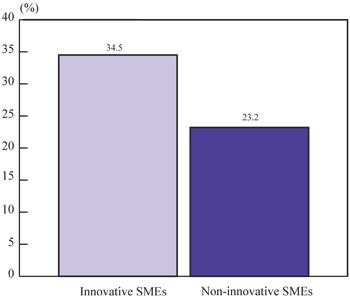
Source: Statistics Canada, Survey on Financing of Small and Medium Enterprises, 2004.
Innovative SMEs were more likely to request debt financing
Among all types of external financing, as shown in Figure 2, innovative SMEs, like non-innovative SMEs, financed their investments through debt more than any other financial instrument with 30.8 percent of innovative SMEs requesting debt financing compared with 18.0 percent of non-innovative SMEs.
Figure 2
Type of financing

Source: Statistics Canada, Survey on Financing of Small and Medium Enterprises, 2004.
It is worth noting that innovative SMEs were also using other financial instruments to a greater extent than non-innovative SMEs. Innovative SMEs were about four times more likely to request equity financing than non-innovative SMEs at 4.9 percent and 1.1 percent respectively. Equity financing encompasses money from friends or relatives of the business owner, employees of the business, business angels, venture capital firms, and Crown corporations or government institutions. Among those innovative SMEs that sought equity financing, 25.8 percent were start-upsFootnote 1 and 65.1 percent had no full-time employees.
There might be two main reasons why more innovative SMEs sought equity financing. First, innovative SMEs tend to be younger than non-innovative SMEs as there were more start-ups among innovative SMEs than non-innovative SMEs (22.1 percent versus 15.2 percent). In the beginning, a firm is unlikely to have sufficient collateral and uncertain prospects to generate the income required to pay back the loan. Start-ups among innovative SMEs had higher request rates (84.6 percent) for debt financing than their non-innovative counterparts (77.9 percent). However, start-ups among innovative SMEs also had lower approval rates (62.5 percent) for debt financing than their non-innovative counterparts (70.6 percent). The second reason more innovative SMEs sought equity financing might be that financial institutions are unwilling to lend to innovative SMEs because they represent a higher risk than non-innovative SMEs, so innovative SMEs have to find other ways to finance their business.
Innovative SMEs were more likely to be turned down by credit suppliers
As mentioned earlier, innovative SMEs were more likely to request debt financing; however, they were less successful in obtaining loans than non-innovative SMEs. As shown in Figure 3, only 54.2 percent of innovative SMEs that requested debt financing received authorization for the credit compared with 83.0 percent of non-innovative SMEs. Innovative SMEs were about twice as likely to be turned down by credit suppliers as non-innovative SMEs (24.5 percent versus 11.8 percent). Moreover, innovative SMEs were about six times more likely to have their loan application still under review at the time the survey was conducted. These findings are consistent with the view that financial institutions consider innovative SMEs more risky than non-innovative SMEs. Higher turndown rates and applications still under review suggest that financing requests from innovative firms may be more difficult to assess and result in lower approval rates.
Figure 3
Authorized and unauthorized debt financing request Note * referrer of Figure 3

Note * of Figure 3: The estimates related to reasons why no amount was authorized for innovative SMEs have a high coefficient of variation and margin of error. Therefore, the estimates may be unreliable.
Source: Statistics Canada, Survey on Financing of Small and Medium Enterprises, 2004.
There were more discouraged borrowers among innovative SMEs
As shown in Figure 4, more innovative SMEs were discouraged (5.3 percent) than non-innovative SMEs (3.9 percent). Discouraged borrowers are those firms that are worthy of receiving financing, but decide not to apply because they think they will be turned down. The higher rate of discouraged borrowers among innovative SMEs may be due to the fact that some innovative SMEs hear that similar firms have had difficulty obtaining financing (i.e. some innovative SMEs had much lower loan approval rates than non-innovative SMEs), so they refrain from applying for financing.
Figure 4
Rate of discouraged borrowers Note * referrer of Figure 4
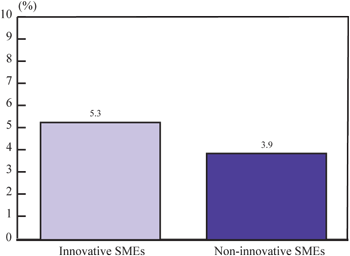
Note * of Figure 4: Kon,Y. and D.J. Storey, 2003. "A Theory of Discouraged Borrowers." Small Business Economics, Vol. 21, No. 1, 37–49. The authors define discouraged borrowers as good firms requiring financing that choose not to apply to credit suppliers because they feel their application will be rejected.
Source: Statistics Canada, Survey on Financing of Small and Medium Enterprises, 2004.
Innovative SMEs tended to rely mostly on chartered banks for debt financing
Close to 80 percent of innovative SMEs approached chartered banks to request new or additional credit compared with approximately 60 percent of non-innovative SMEs (Figure 5). As a result, fewer innovative SMEs approached credit unions or Caisses populaires for new or additional credit than non-innovative SMEs (15.1 percent versus 24.0 percent). Results also show that more innovative SMEs chose the transactional approach and fewer the relational approach to obtain financing than non-innovative SMEs.Footnote 2
Figure 5
Type of financial institution approached
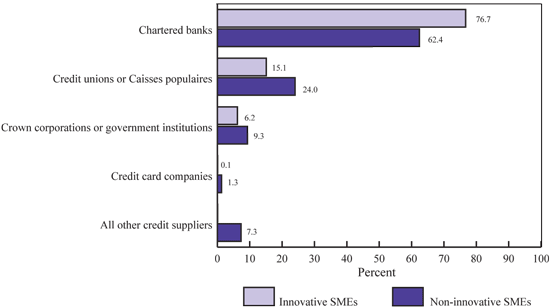
Source: Statistics Canada, Survey on Financing of Small and Medium Enterprises, 2004.
Innovative SMEs were less likely to be approved for debt financing by credit unions or Caisses populaires than chartered banks
As mentioned earlier, innovative SMEs were less successful in obtaining loans than non-innovative SMEs. Moreover, Figure 6 indicates that credit unions or Caisses populaires were less likely to approve debt requested by innovative SMEs than chartered banks (33.3 percent versus 56.8 percent). It is worth noting that the approval rates did not differ much between chartered banks and credit unions or Caisses populaires for non-innovative SMEs at 81.3 percent and 83.3 percent respectively.
Figure 6
Debt approval rate
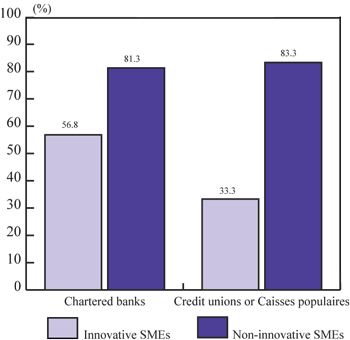
Source: Statistics Canada, Survey on Financing of Small and Medium Enterprises, 2004.
A new line of credit was the most popular credit instrument among innovative SMEs
As shown in Figure 7, more than 60 percent of innovative SMEs requested a new line of credit from credit suppliers compared with 32.9 percent of non-innovative SMEs. A similar proportion of non-innovative SMEs requested a term loan (33.3 percent). Innovative SMEs, on the other hand, were about 1.5 times less likely to request term loans, 4.7 times less likely to request mortgage loans and 1.3 times less likely to request an increase in the credit limit of current lines of credit than non-innovative SMEs.
Figure 7
Type of loan requested

Source: Statistics Canada, Survey on Financing of Small and Medium Enterprises, 2004.
Close to 80 percent of innovative SMEs intended to use the financing requested for working and operating capital
Figure 8 indicates that 78.9 percent of innovative SMEs intended to use the financing requested for working and operating capital compared with 54.6 percent of non-innovative SMEs. A similar proportion of non-innovative SMEs intended to use the financing requested for fixed assets (50.3 percent). It is worth noting that innovative SMEs were about six times more likely to use the financing requested for research and development than non-innovative SMEs (16.6 percent versus 2.8 percent).
Figure 8
Purpose of debt financing
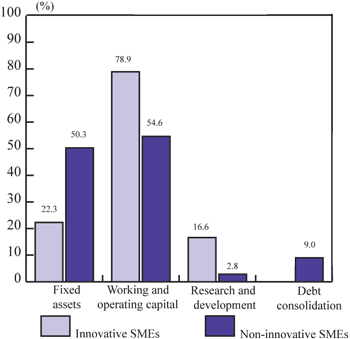
Source: Statistics Canada, Survey on Financing of Small and Medium Enterprises, 2004.
Equity financing accounted for the highest share of the total financing authorized for innovative SMEs
Innovative SMEs received higher average amounts of lease and equity financing but lower average amounts of debt financing than non-innovative SMEs (Table 3). It is worth noting that for each financing instrument, the median amount was much lower than the average amount. This indicates that a small number of firms received large amounts of financing (see the maximum amount received by innovative and non-innovative SMEs for each type of financing instrument), which brings the average up. For example, the median amount of debt financing authorized for innovative SMEs was $20 000, indicating that 50 percent of innovative SMEs received less than $20 000 and 50 percent of innovative SMEs received more than $20 000, whereas the average amount of debt financing authorized for innovative SMEs was $51 181. The average amount of equity financing authorized for innovative SMEs did not differ much from that authorized for non-innovative SMEs ($466 315 versus $447 183); however, the median amount of equity financing for innovative SMEs was only about one third of the median for non-innovative SMEs. This finding could, a priori, be somewhat surprising given, as noted previously, that innovative SMEs use other financing instruments to a greater extent than non-innovative SMEs. However, the lower amount of equity raised can be explained by the fact that there are more start-ups among innovative SMEs, and they rely more on love money from friends and relatives for their financing needs.
| Innovative SMEs | Non-Innovative SMEs | |||||
|---|---|---|---|---|---|---|
| Average ($) | Median ($) | Maximum ($) | Average ($) | Median ($) | Maximum ($) | |
| Source: Statistics Canada, Survey on Financing of Small and Medium Enterprises, 2004. | ||||||
| Debt | 51 181 | 20 000 | 2 500 000 | 153 222 | 45 000 | 9 000 000 |
| Lease | 119 872 | 52 000 | 600 000 | 66 381 | 40 000 | 1 900 000 |
| Equity | 466 315 | 40 000 | 5 000 000 | 447 183 | 120 000 | 6 000 000 |
As illustrated in Figure 9, debt financing accounted for the highest share of the total financing authorized for non-innovative SMEs, but equity financing accounted for the highest share for innovative SMEs. Lease financing accounted for 22.8 percent of the total financing authorized for innovative SMEs compared with 8.0 percent for non-innovative SMEs.
Figure 9
Share of authorized financing
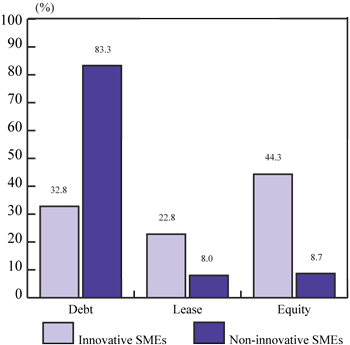
Source: Statistics Canada, Survey on Financing of Small and Medium Enterprises, 2004.
Although the average amount of equity financing received by innovative and non-innovative SMEs did not differ much ($466 315 versus $447 183), the amount of equity financing received by innovative SMEs represented 44.3 percent of the total financing received, whereas the amount of equity financing received by non-innovative SMEs represented only 8.7 percent of the total financing received. This indicates that innovative SMEs are more dependent on equity financing than non-innovative SMEs.
Innovative SMEs were three times more likely to request equity financing from a venture capital firm
Figure 10 shows that innovative SMEs tended to approach business angels and friends/relatives to request equity financing. They were three times more likely to approach a venture capital firm than non-innovative SMEs. Typically, innovative SMEs have few physical assets, often base their strategic plans on new technologies and have higher than average business risks. Because of these high risks, it is difficult for innovative SMEs to access debt financing. Venture capital firms, on the other hand, finance high-risk firms in which traditional financial institutions are unwilling to invest. Although venture capital involves a time horizon of many years and many failures, the potential returns on a winning venture portfolio are very high. Moreover, there are more start-ups among innovative SMEs than non-innovative SMEs and Canada's venture capital firms emphasize early-stage financing.Footnote 3 The amount of financing provided by angel investors and venture capital firms represented 90 percent of the total equity financing received by innovative SMEs compared with only 42.3 percent received by non-innovative SMEs.
Figure 10
Type of financier approached for equity financing Note * referrer of Figure 10

Note * of Figure 10: The estimates related to type of financiers approached by innovative SMEs have a high coefficient of variation and margin of error. Therefore, the estimates may be unreliable.
Source: Statistics Canada, Survey on Financing of Small and Medium Enterprises, 2004.
B. Financing terms and conditions
Financing terms and conditions for innovative SMEs reflect their high-risk profile: loan terms were shorter and interest rates were higher
Table 4 shows the average interest rate and the average length of the term of authorized credit that Canadian SMEs had in 2004. Innovative SMEs paid higher interest rates for short-term loans, term loans, new lines of credit and increases in the credit limit of current lines of credit. For term loans, innovative SMEs had slightly higher interest rates for shorter terms (46 months versus 62 months). A better comparison can be made by adjusting the length of the loan terms to the same period, for example, to 60 months. This adjustment shows that the interest rate paid by innovative SMEs was 0.5 percentage points higher than that paid by non-innovative SMEs (6.8 percent versus 6.3 percent).
| Innovative SMEs | Non-Innovative SMEs | |
|---|---|---|
| Note: "‒" indicates estimates suppressed to meet confidentiality requirements of the Statistics Act or for low data quality reasons. Source: Statistics Canada, Survey on Financing of Small and Medium Enterprises, 2004. | ||
| Demand or short-term loan | ||
| Average interest rate | 7.9 | 5.9 |
| Average length of term (months) | 11 | 9 |
| Term loan | ||
| Average interest rate | 6.3 | 6.2 |
| Average length of term (months) | 46 | 62 |
| Mortgage loan | ||
| Average interest rate | 5.3 | 5.7 |
| Average length of term (months) | ‒ | 125 |
| New line of credit | ||
| Average interest rate | 6.2 | 6.1 |
| New credit card | ||
| Average interest rate | 17.1 | 17.5 |
| Increase in credit limit of current lines of credit | ||
| Average interest rate | 6.2 | 5.9 |
| Increase in credit limit of current credit cards | ||
| Average interest rate | ‒ | 13.9 |
| All other financing instruments | ||
| Average interest rate | ‒ | 6.4 |
Fewer innovative SMEs were requested to offer collateral or to meet co-signing requirements as a condition of obtaining financing
Fewer innovative SMEs were requested by credit suppliers to provide business or personal assets as collateral to obtain financing. As shown in Figure 11, 31.1 percent of innovative SMEs were requested to provide business assets as collateral to obtain financing compared with 42.3 percent of non-innovative SMEs. Similarly, 33.1 percent of innovative SMEs were asked to provide personal assets compared with 42.6 percent of non-innovative SMEs. These findings could reflect the fact that innovative SMEs often lack collateral that can be used to secure bank loans. Since financing assets pledged as collateral is less risky, innovative SMEs have more difficulties in obtaining financing.
Figure 11
Type of collateral requested
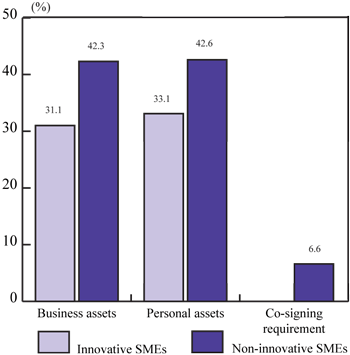
Source: Statistics Canada, Survey on Financing of Small and Medium Enterprises, 2004.
Over 50 percent of innovative SMEs were asked to provide business financial statements or formal applications for credit applications
A business financial statement was the most frequently requested document for a credit application. As Figure 12 shows, 55.9 percent of innovative SMEs were requested to provide a business financial statement for credit applications compared with 61.8 percent of non-innovative SMEs. Formal applications were also a common document requested by lenders, with 56.0 percent of innovative SMEs requested to provide a formal application for credit compared with 52.9 percent of non-innovative SMEs.
Figure 12
Documentation required as part of the application process
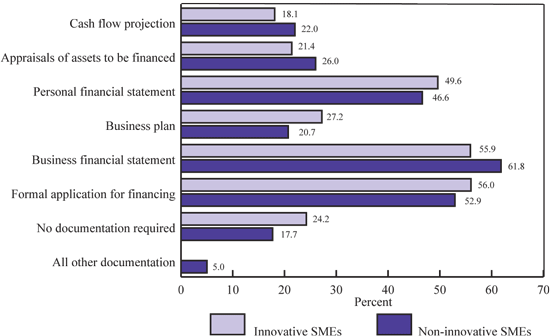
Source: Statistics Canada, Survey on Financing of Small and Medium Enterprises, 2004.
C. Obstacles faced by SMEs in accessing financing
The main obstacles faced by non-innovative SMEs in accessing financing were insufficient income, sales or cash flow (32.2 percent), insufficient collateral security (16.2 percent) and poor credit experience or history (10.9 percent). Estimates related to obstacles faced by innovative SMEs were suppressed to meet Statistics Canada confidentiality requirements. It was not possible, therefore, to compare the obstacles faced by innovative and non-innovative SMEs in accessing financing.
Summary and conclusions
Innovation has been recognized as an essential component of the economic growth process. There is much research on the various underlying aspects of innovation, but there is little on its financing, even though it is recognized as a key determinant. It is generally accepted that it is more difficult for innovative SMEs to access financing, but such claims are usually not substantiated. Using data from the Statistics Canada Survey on Financing of Small and Medium Enterprises, 2004, this report has profiled innovative SMEs along a range of characteristics and examined whether they differ from non-innovative SMEs in terms of access to financing, financing terms and conditions, and obstacles faced in accessing financing.
The findings of this case study have shown that innovative SMEs, which account for 4.2 percent of SMEs in Canada, have different financing activities and experiences than non-innovative SMEs. Innovative SMEs had greater financing needs than non-innovative SMEs, but were less successful in obtaining the financing requested. The report shows that financing terms and conditions for innovative SMEs are consistent with their perceived higher risk by financial institutions.
Innovative SMEs were about four times more likely to request equity financing than non-innovative SMEs. Equity financing is important to innovative SMEs as it represented 44.3 percent of the total financing received compared with only 8.7 percent for non-innovative SMEs. Moreover, innovative SMEs were three times more likely to request equity financing from a venture capital firm than non-innovative SMEs. It was also shown that innovative SMEs were about six times more likely to use the debt financing requested for research and development.
Canadian innovative SMEs face more constraining financing terms and conditions than non-innovative SMEs. For example, innovative SMEs paid higher interest rates and got shorter loan terms. This is consistent with the fact that financial institutions consider innovative SMEs more risky than non-innovative SMEs as innovation often involves the continuous development of new products and use of new processes in untested markets.
This report was unable to examine the obstacles faced by innovative SMEs in accessing financing because the data were suppressed to meet Statistics Canada confidentiality requirements. It can only be inferred that, based on the experience of non-innovative SMEs, the most likely obstacles are insufficient income, sales or cash flow; insufficient collateral security and poor credit experience or history.
References
- Berger, A. and G.G. Udell, 2005. A More Complete Conceptual Framework for Financing of Small and Medium Enterprises. World Bank Policy Research Working Paper 3795.
- Kon, Y. and D.J. Storey, 2003. "A Theory of Discouraged Borrowers." Small Business Economics, Vol. 21, No. 1, 37–49.
- Statistics Canada, Survey on Financing of Small and Medium Enterprises, 2004.
Financing Profiles is an ongoing series of articles on specific segments of the marketplace and a component of Industry Canada's reporting efforts on SME financing.
Statistics Canada administers a series of national surveys on small and medium-sized enterprises (Survey on Financing of Small and Medium Enterprises) and financial providers (Survey of Suppliers of Business Financing). Industry Canada supplements these surveys with additional research into niche areas of SME financing.
For further information regarding the methodology of the Survey on Financing of Small and Medium Enterprises, visit Statistics Canada's website at www.statcan.ca.
For further information on this profile, email SBB-DGPE.
Appendix
| NAICS Code | Description |
|---|---|
| Note * of Table A: The North American Industry Classification System (NAICS) is a two-digit through six-digit hierarchical classification code system offering five levels of detail. The first two digits designate the economics sector, the third the subsector, the fourth the industry group, the fifth the NAICS industry and the sixth the national industry. Statistics Canada, Survey on Financing of Small and Medium Enterprises, 2004. | |
| 22 | Utilities |
| 52 | Finance and Insurance |
| 55 | Management of Companies and Enterprises |
| 61 | Educational Services |
| 91 | Public Administration |
| 5321 | Automotive Equipment Rental and Leasing |
| 5324 | Machinery and Equipment Rental and Leasing |
| 6214 | Out-Patient Care Centres |
| 6215 | Medical and Diagnostic Laboratories |
| 6219 | Other Ambulatory Health Care Services |
| 6221 | General Medical and Surgical Hospitals |
| 6222 | Psychiatric and Substance Abuse Hospitals |
| 6223 | Specialty (except Psychiatric and Substance Abuse) Hospitals |
| 6242 | Community Food and Housing, and Emergency and Other Relief Services |
